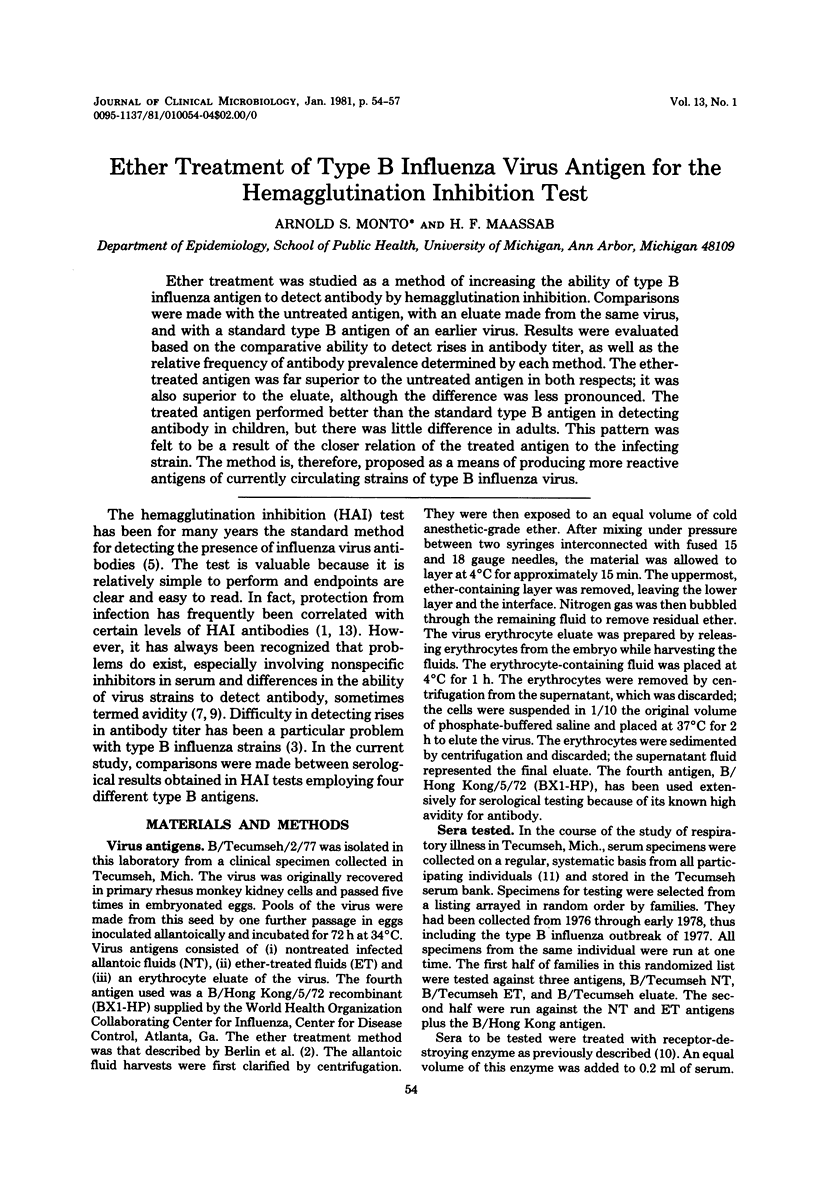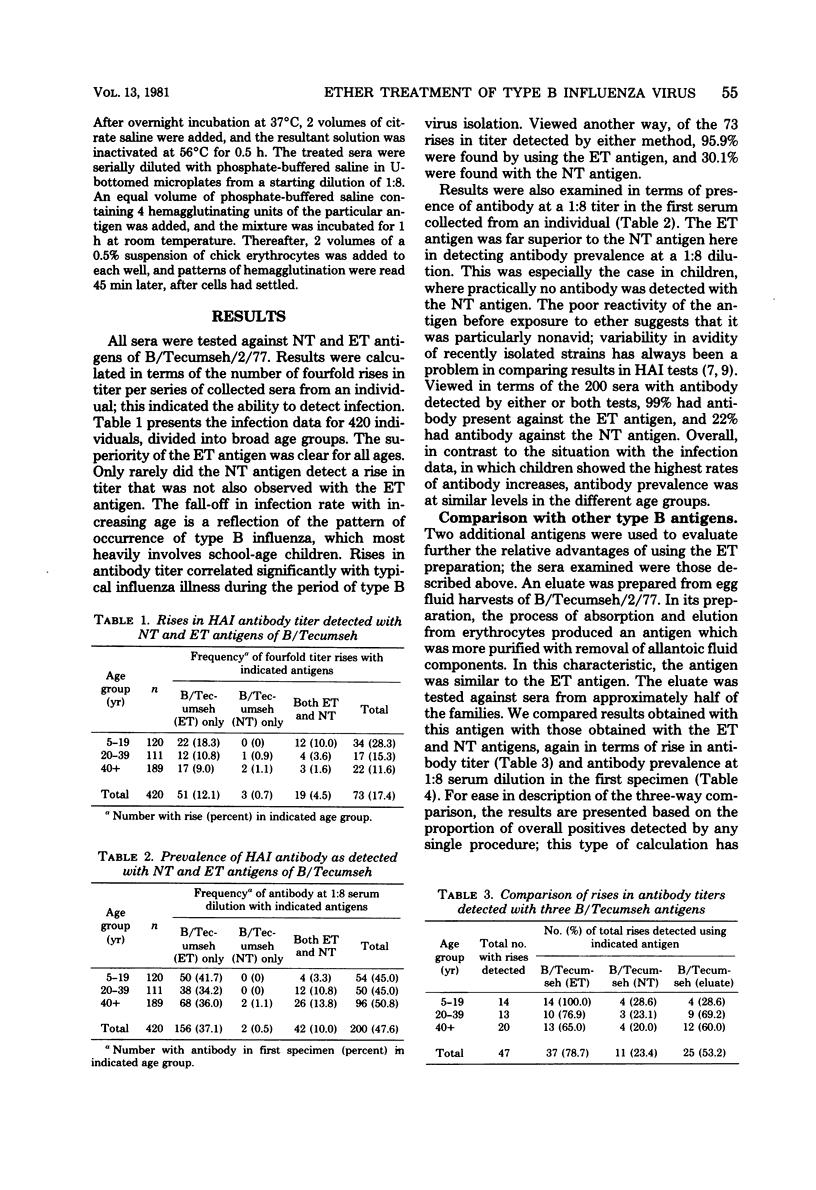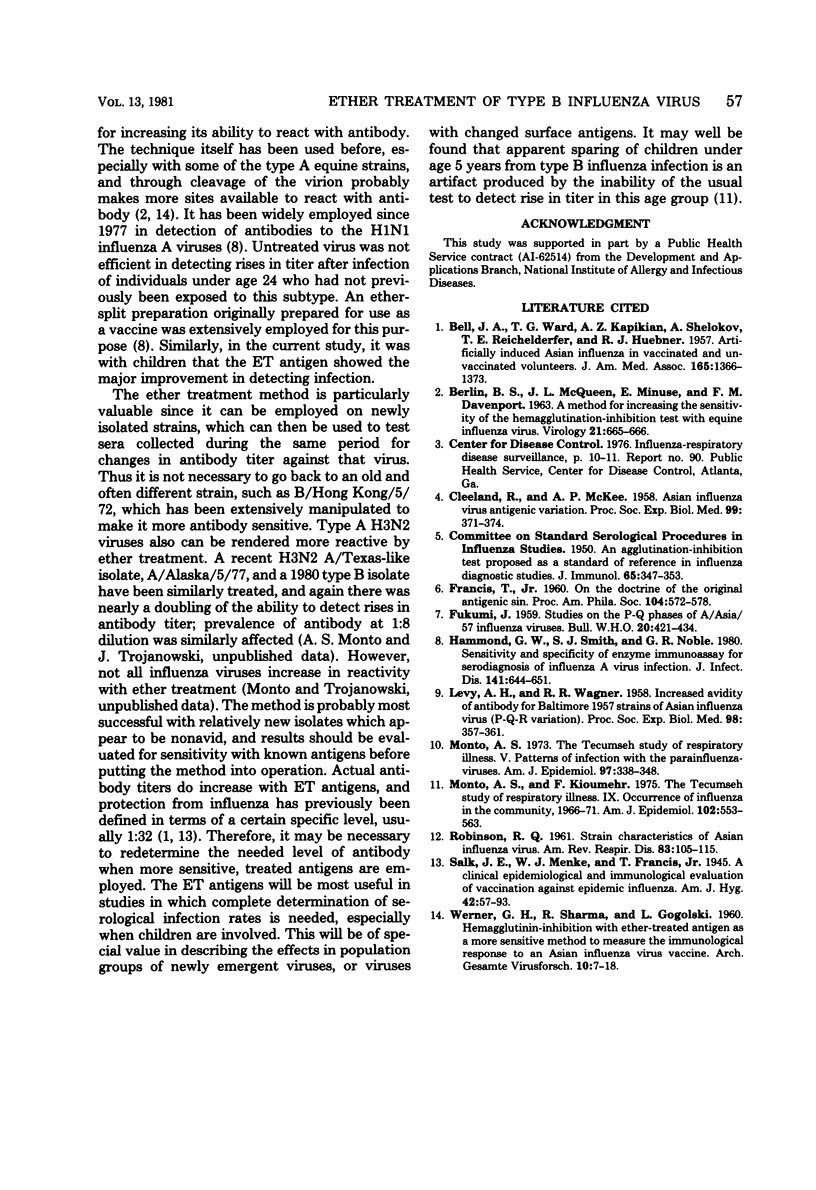Abstract
Ether treatment was studied as a method of increasing the ability of type B influenza antigen to detect antibody by hemagglutination inhibition. Comparisons were made with the untreated antigen, with an eluate made from the same virus, and with a standard type B antigen of an earlier virus. Results were evaluated based on the comparative ability to detect rises in antibody titer, as well as the relative frequency of antibody prevalence determined by each method. The ether-treated antigen was far superior to the untreated antigen in both respects; it was also superior to the eluate, although the difference was less pronounced. The treated antigen performed better than the standard type B antigen in detecting antibody in children, but there was little difference in adults. This pattern was felt to be a result of the closer relation of the treated antigen to the infecting strain. The method is, therefore, proposed as a means of producing more reactive antigens of currently circulating strains of type B influenza virus.
Full text
PDF



Selected References
These references are in PubMed. This may not be the complete list of references from this article.
- BELL J. A., WARD T. G., KAPIKIAN A. Z., SHELOKOV A., REICHELDERFER T. E., HUEBNER R. J. Artificially induced Asian influenza in vaccinated and unvaccinated volunteers. J Am Med Assoc. 1957 Nov 16;165(11):1366–1373. doi: 10.1001/jama.1957.02980290006002. [DOI] [PubMed] [Google Scholar]
- BERLIN B. S., MCQUEEN J. L., MINUSE E., DAVENPORT F. M. A METHOD FOR INCREASING THE SENSITIVITY OF THE HEMAGGLUTINATION-INHIBITION TEST WITH EQUINE INFLUENZA VIRUS. Virology. 1963 Dec;21:665–666. doi: 10.1016/0042-6822(63)90244-7. [DOI] [PubMed] [Google Scholar]
- CLEELAND R., McKEE A. P. Antigenic variation of Asian influenza virus. Proc Soc Exp Biol Med. 1958 Nov;99(2):371–374. doi: 10.3181/00379727-99-24354. [DOI] [PubMed] [Google Scholar]
- FUKUMI H. Studies on the P-Q phases of A/Asia/57 influenza viruses. Bull World Health Organ. 1959;20(2-3):421–434. [PMC free article] [PubMed] [Google Scholar]
- Hammond G. W., Smith S. J., Noble G. R. Sensitivity and specificity of enzyme immunoassay for serodiagnosis of influenza A virus infections. J Infect Dis. 1980 May;141(5):644–651. doi: 10.1093/infdis/141.5.644. [DOI] [PubMed] [Google Scholar]
- LEVY A. H., WAGNER R. R. Increased avidity of antibody for Baltimore 1957 strains of Asian influenza virus (P-Q-R variation). Proc Soc Exp Biol Med. 1958 Jun;98(2):357–361. doi: 10.3181/00379727-98-24043. [DOI] [PubMed] [Google Scholar]
- Monto A. S., Kioumehr F. The Tecumseh Study of Respiratory Illness. IX. Occurence of influenza in the community, 1966--1971. Am J Epidemiol. 1975 Dec;102(6):553–563. doi: 10.1093/oxfordjournals.aje.a112193. [DOI] [PubMed] [Google Scholar]
- Monto A. S. The Tecumseh study of respiratory illness. V. Patterns of infection with the parainfluenzaviruses. Am J Epidemiol. 1973 May;97(5):338–348. doi: 10.1093/oxfordjournals.aje.a121514. [DOI] [PubMed] [Google Scholar]
- ROBINSON R. Q. Strain characteristics of Asian influenza virus. Am Rev Respir Dis. 1961 Feb;83(2):105–115. doi: 10.1164/arrd.1961.83.2P2.105. [DOI] [PubMed] [Google Scholar]
- WERNER G. H., SHARMA R., GOGOLSKI L. Hemagglutinin inhibition with ether-treated antigen as a more sensitive method to measure the immunological response to an Asian influenza virus vaccine. Arch Gesamte Virusforsch. 1960;10:7–18. doi: 10.1007/BF01258764. [DOI] [PubMed] [Google Scholar]


